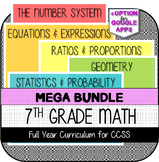7th Grade Math STATISTICS UNIT BUNDLE
- Zip

What educators are saying
Products in this Bundle (12)
showing 1-5 of 12 products
Bonus
Also included in
- NOTE: Google Apps Options - All assessments & test practice from notes are included as optional Google Forms as well as other supplemental material. However, this curriculum is meant to be primarily PDF print-outs and may not be ideal for "Distance Learning" unless you have special access to PDFPrice $175.00Original Price $250.49Save $75.49
Description
This resource contains notes, practice assignments, and assessments covering the 7th grade math statistics standards with the following main topics:
1) Reviewing Data Displays (Box Plots, Dot Plots, Histograms)
2) Valid Samples
3) Inferences from Data Samples
4) Comparing Data
5) Understanding Overlapping Data
See the PREVIEW file for specific lessons and Google Apps information.
This resource was developed to meet the requirements of the 7th Grade Statistics & Probability Standards below:
Use random sampling to draw inferences about a population.
CCSS.MATH.CONTENT.7.SP.A.1
Understand that statistics can be used to gain information about a population by examining a sample of the population; generalizations about a population from a sample are valid only if the sample is representative of that population. Understand that random sampling tends to produce representative samples and support valid inferences.
CCSS.MATH.CONTENT.7.SP.A.2
Use data from a random sample to draw inferences about a population with an unknown characteristic of interest. Generate multiple samples (or simulated samples) of the same size to gauge the variation in estimates or predictions. For example, estimate the mean word length in a book by randomly sampling words from the book; predict the winner of a school election based on randomly sampled survey data. Gauge how far off the estimate or prediction might be.
Draw informal comparative inferences about two populations.
CCSS.MATH.CONTENT.7.SP.B.3
Informally assess the degree of visual overlap of two numerical data distributions with similar variabilities, measuring the difference between the centers by expressing it as a multiple of a measure of variability. For example, the mean height of players on the basketball team is 10 cm greater than the mean height of players on the soccer team, about twice the variability (mean absolute deviation) on either team; on a dot plot, the separation between the two distributions of heights is noticeable.
CCSS.MATH.CONTENT.7.SP.B.4
Use measures of center and measures of variability for numerical data from random samples to draw informal comparative inferences about two populations. For example, decide whether the words in a chapter of a seventh-grade science book are generally longer than the words in a chapter of a fourth-grade science book.
LICENSING TERMS: This purchase includes a license for one teacher only for personal use in their classroom. Licenses are non-transferable, meaning they can not be passed from one teacher to another. No part of this resource is to be shared with colleagues or used by an entire grade level, school, or district without purchasing the proper number of licenses.
COPYRIGHT TERMS: This resource may not be uploaded to the internet in any form, including classroom/personal websites or network drives, unless the site is password protected and can only be accessed by students.



